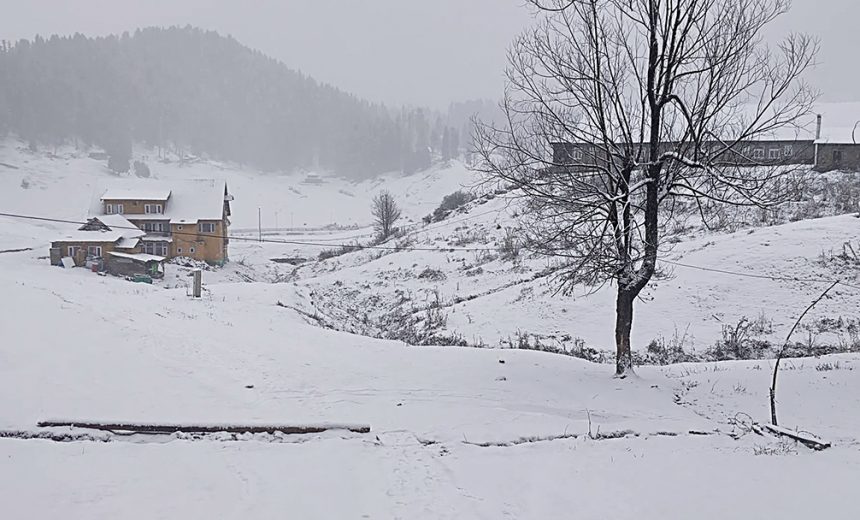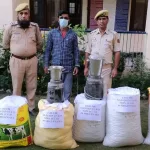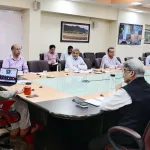Srinagar, Feb 23:
The prolonged dry spell in the Kashmir Valley, combined with drought-like conditions, has dealt a devastating blow to the region’s winter tourism sector. The valley, once famous for its pristine snow-covered landscapes, has been gripped by an alarming lack of snowfall this year, leading to a significant decline in visitors, especially to Gulmarg, the region’s premier winter destination.
Tourism stakeholders report a 40% drop in visitors to Gulmarg, with other areas of the valley seeing an even steeper decline of 50%. This crisis has triggered widespread economic distress across sectors reliant on tourism, from hoteliers to tourist guides, shopkeepers, and horsemen.
“This winter has been unlike any we’ve seen,” said Aqib Chaya, President of the Hoteliers Association Kashmir. He explained that the low snowfall has significantly impacted tourist numbers, particularly in the peak winter months. “From December to March, Gulmarg used to be packed with tourists, but this year, bookings have dropped drastically,” Chaya said. He noted that the recent mild snowfall provided only a slight recovery in tourism numbers, but it wasn’t enough to make up for the significant losses.
The economic blow was compounded by the postponement of the Khelo India Winter Games — a major sporting event that was scheduled to take place in Gulmarg in February. The event’s cancellation, due to inadequate snowfall, led to the cancellation of over 800 hotel room bookings, resulting in major financial losses for the hospitality industry. A hotelier in Gulmarg revealed that the last-minute cancellation of the week-long event caused a 50% drop in bookings, leaving many businesses in disarray.
“We have suffered huge losses due to the decline in tourism and low snowfall,” lamented a hotelier in Gulmarg, echoing the frustrations of many in the industry. With many tourists hoping to experience the famous snowy landscapes of Kashmir, the lack of snow has left visitors disappointed and businesses struggling.
The tourism sector’s woes have trickled down to local guides, houseboat owners, and small shopkeepers, all of whom depend heavily on winter tourism. Rafiq Ahmad, a tourist guide in Gulmarg, shared his frustration: “In my 15 years of guiding tourists through Kashmir’s snowy wonders, I’ve never seen anything like this. The winter games, which were a major attraction, are non-existent this year due to the prolonged dry spell.” Ahmad, like many others, voiced concerns over the loss of livelihood as the absence of snow has meant fewer tourists and activities.
Mohammed Akram, a veteran guide from Tangmarg, described how the snow-capped mountains and frozen lakes were once the hallmark of Kashmir’s winter tourism. “Now, it feels like the heart of Kashmir is missing,” Akram said, noting that “tourists come expecting a magical experience, but they leave disappointed by the lack of snow.” He, like others in the sector, emphasized the drastic drop in bookings and income, which are closely tied to the snowy landscapes of the region.
The shopkeepers, who once thrived on the winter crowds purchasing snow gear, local handicrafts, and souvenirs, are also facing financial uncertainty. Ghulam Hassan Malik, a shopkeeper from Kenzar Tangmarg, stated that “Our shops used to be filled with tourists, but this year, it’s eerily quiet. Without snowfall, our businesses are struggling.” He added that snowfall wasn’t just a spectacle but the very soul of Kashmir’s tourism, and without it, their livelihoods are at risk.
Even the local horsemen, who typically provide rides through the snow-covered trails of Gulmarg, are now facing hardship. Gulzar Bhat, a local horseman, explained, “Snowfall is not just a blessing for tourists, but for us as well. It means steady income and enough to sustain our families for the year. Now, with little snow, our horses are idle, and we don’t know how to make ends meet.”
Beyond the immediate economic losses, the dry winters have raised concerns among environmentalists and climate experts, with Dr. Irfan Rashid, Senior Assistant Professor at the Department of Geoinformatics, University of Kashmir, warning of the long-term environmental impact. He pointed out that this year marks a snowless winter after seven years, with the crucial Chillaikalaan period (the harshest part of winter) experiencing a severe lack of snow.
“The dry winters mean higher mass loss of glaciers, which will affect glacier health, streamflow, and the entire hydrological cycle. If the weather conditions do not improve, it might impact hydropower generation, irrigation, and other sectors dependent on the region’s water resources,” Dr. Rashid said. He also highlighted how this climatic shift could lead to future disruptions in ski tourism and other winter-related activities that are vital for the region’s economy.
Kashmir’s tourism struggles as snowless winter hits local businesses
Gulmarg faces 40% drop in tourists Khelo India Winter Games postponement deepens tourism woes

Leave a Comment Leave a Comment







